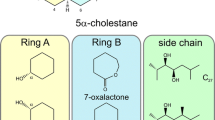Abstract
An efficient method for the simultaneous extraction and quantification of both jasmonic acid (JA) and methyl jasmonate (MeJA) from a single plant sample was developed. Plant tissues were firstly extracted by using 100% cold methanol, then the Sep-pak C18 solid-phase extraction (SPE) cartridges were adopted for the purification of sample extract, and finally JA and MeJA were determined by the liquid chromatography tandem mass spectrometry (LC-MS-MS) system. It was found that the accuracy was improved by using the extra standard for the estimation and correction of JA and MeJA losses in the extraction and purification process. The detection limits for JA and MeJA were 0.03 and 0.075 ng mL−1, respectively, and the average recovery rate of JA and MeJA was 92.48% and 94.30%. The method was found to be reproducible and selective, yielding well isolated and easily detectable peaks for both JA and MeJA and simplifying the time-consuming extraction and purification. High-performance liquid chromatography (HPLC) system was employed as the control detection method for the LC-MS-MS system. The two systems were compared in their specificity and accuracy.
Similar content being viewed by others
References
Creelman R A, Mullet J E. Biosynthesis and action of jasmonates in plants. Annu Rev Plant Physiol Plant Mol Biol, 1997, 48: 355–381
Ueda J, Kato J. Isolation and identification of senescence promoting substance from worm wood. Plant Physiol, 1980, 66: 246–249
Farmer E E, Ryan C A. Octadecanoid precursors of jasmonic acid activate the synthesis of wound-inducible proteinase inhibitors. Plant Cell, 1992, 4: 129–134
Sembdner G, Parthier B. The biochemistry and the physiological and molecular actions of jasmonates. Annu Rev Plant Physiol Plant Mol Biol, 1993, 44: 569–589
Maucher H, Hause B, Feussner I, et al. Allene oxide synthesis of barley (Hordeum vulgare cv.Salome): Tissue specific regulation in seedling development. Plant J, 2000, 21: 199–213
Hause B, Stenzel I, Miersch O, et al. Tissue-specific oxylipin signature of tomato flowers: Allene oxide cyclase is highly expressed in distinct flower organs and vascular bundles. Plant J, 2000, 24: 113–126
Schaller F. Enzymes of the biosynthesis of octadecanoid-derived signaling molecules. J Exp Bot, 2001, 52: 11–23
Liu X, Zhang S Q. Functional mechanisms of JAs in wounding signal transduction pathways (in Chinese with English abstract). Acta Phytophysiol Sin, 2000, 36: 76–81
Wu J S, Chong K. The molecular biology research on the action of jasmonates (in Chinese). Chinese Bull Bot, 2002, 19: 164–170
Gundlach H, Müller M J, Kutchan T M, et al. Jasmonic acid is a signal transducer in elicitor-induced plant cell cultures. Proc Natl Acad Sci USA, 1992, 89: 2389–2393
McConn M, Creelman R A, Bell E, et al. Jasmonate is essential for insect defense in Arabidopsis. Proc Natl Acad Sci USA, 1997, 94: 5473–5477
Wasternack C, Parthier B. Jasmonate-signalled plant gene expression. Trends Plant Sci, 1997, 2: 302–307
Xie D X, Feys B F, James S, et al. COII: An Arabidopsis gene required for jasmonate-regulated defense and fertility. Science, 1998, 280: 1091–1094
Sanders P M, Lee P Y, Biesgen C, et al. The Arabidopsis delayed dehiscence1gene encodes an enzyme in the jasmonic acid synthesis pathway. Plant Cell, 2000, 12: 1041–1061
Chiwocha S D S, Abrams S R, Ambrose S J, et al. A method for profiling classes of plant hormones and their metabolites using liquid chromatography-electrospray ionization tandem mass spectrometry: An analysis of hormone regulation of the rmodormancy of lettuce (Lactuca sativa L.) seeds. Plant J, 2003, 35: 405–417
Albrecht T, Kehlen A, Stahl K, et al. Quantification of rapid, transient increases in jasmonic acid in wounded plants using a monoclonal antibody. Planta, 1993, 191: 86–94
Anderson J M. Simultaneous determination of absicisic acid and jasmonic acid in plant extracts using High Performance Liquid Chromatography. J. Chromatogr, 1985, A 330: 347–355
Mueller M J, Brodschelm W. Quantification of jasmonic acid by capillary gas chromatography-negative chemical-ionization mass-spectrometry. Anal Biochem, 1994, 218: 425–435
Wilbert S M, Ericsson L H, Gordon M P. Quantification of jasmonic acid, methyl jasmonate, and salicylic acid in plants by capillary liquid chromatography electrospray tandem mass spectrometry. Anal Biochem, 1998, 257: 186–194
Kristl J, Veber M, Krajnicic B, et al. Determination of jasmonic acid in Lemna minor (L. by liquid chromatography with fluorescence detection. Anal Bioanal Chem, 2005, 383: 886–893
Author information
Authors and Affiliations
Corresponding author
About this article
Cite this article
Liu, X., Yang, Y., Lin, W. et al. Determination of both jasmonic acid and methyl jasmonate in plant samples by liquid chromatography tandem mass spectrometry. Chin. Sci. Bull. 55, 2231–2235 (2010). https://doi.org/10.1007/s11434-010-3194-4
Received:
Accepted:
Published:
Issue Date:
DOI: https://doi.org/10.1007/s11434-010-3194-4




